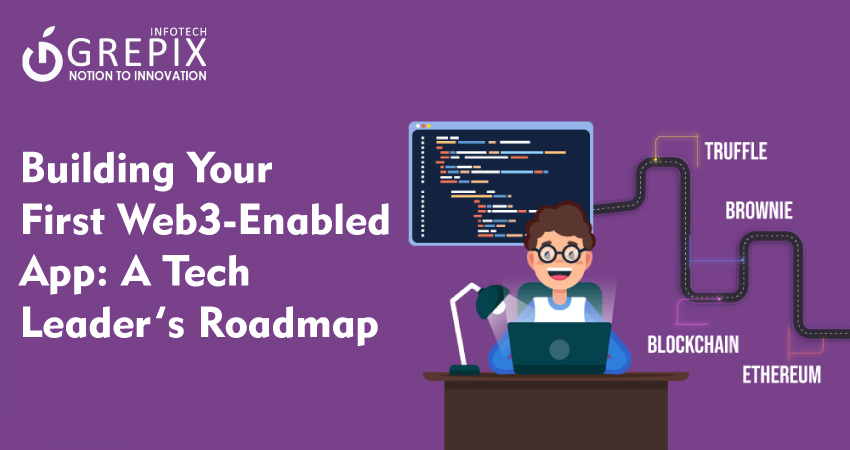Building Your First Web3-Enabled App: A Tech Leader’s Roadmap
In 2025, it’s hard to ignore the wave of change Web3 is bringing. From buzzwords like decentralization and blockchain to real-world use cases in finance, gaming, and social networks the Web3 world is no longer just for crypto nerds. If you’re a tech leader thinking, "Should I build a Web3-enabled app now?" The answer is, without a doubt, yes.
This roadmap is for you. Whether you're a CTO, startup founder, or product manager, this guide simplifies the complexities of Web3 development into a practical, global, and jargon-free blueprint.
Web3 is revolutionizing how we build and interact with digital platforms by shifting control from centralized authorities to users themselves. This blog offers a clear, step-by-step roadmap for tech leaders looking to develop their first Web3-enabled app. From choosing the right blockchain and writing smart contracts to deploying dApps and building communities, each phase is designed for global accessibility and real-world impact. We cover common mistakes, security best practices, and use cases across industries like finance, gaming, healthcare, and real estate. With relatable stories and practical tools, this guide is your launchpad into decentralized development. Finally, Grepix Infotech stands ready to help you turn your Web3 vision into reality with end-to-end development support.
What Is a Web3 App, Anyway?
Think of Web3 apps like the next evolution of the internet. While Web1 gave us static websites and Web2 brought user-generated content and platforms like Facebook, Web3 introduces a decentralized internet.
In simple terms:
- Web1 = Read
- Web2 = Read + Write
- Web3 = Read + Write + Own
A Web3 app, or dApp (decentralized app), is built on blockchain technology. It removes middlemen, giving power back to users through smart contracts and crypto-based incentives.
Examples You Know
- Ethereum-based apps like Uniswap: A decentralized crypto exchange.
- Axie Infinity: A play-to-earn game where players own in-game assets.
- Brave Browser: Rewards users with crypto for viewing ads.
Why Should You Build a Web3-Enabled App?
Here’s why tech leaders are hopping on the Web3 train:
- User Ownership
- Global Access
- New Monetization Models
- Innovation Edge
Users don’t just use your platform; they own parts of it. This boosts loyalty.
No banks? No problem. Web3 is borderless, making it perfect for emerging markets.
From token launches to NFT sales, the possibilities are endless.
Web3 is still a growing field. Being early means being ahead.
"Web3 isn't the future. It's happening right now."
The Web3 App Development Roadmap
Let’s break it down, step by step.
Step 1: Define Your Use Case
Ask yourself:
- What problem does your app solve?
- Can decentralization genuinely improve it?
Examples:
- A decentralized ride-sharing app: No middlemen, better payouts.
- A healthcare app using blockchain: Immutable medical records.
Step 2: Choose the Right Blockchain
Choosing the right blockchain is one of the most critical decisions in your Web3 app development journey. The ideal platform depends on your use case, scalability needs, budget, and development timeline. Ethereum, for instance, is known for its versatility and active developer community, making it great for general-purpose dApps, although it suffers from slower speeds and higher gas fees. If speed and low cost are top priorities, Solana is a strong contender, albeit with less decentralization.
Polygon is a scalable, Ethereum-compatible option that offers a good balance between cost and compatibility, but it’s still evolving. For fintech apps where low fees are crucial, Binance Smart Chain offers great efficiency but comes with concerns about centralization. Understanding these trade-offs will help you choose the best foundation for your Web3 project.
Step 3: Set Up Your Wallets & Testnet
You need a crypto wallet (like MetaMask) to interact with the blockchain. For dev work, use testnets:
- Ethereum Testnets: Goerli, Sepolia
- Solana Testnet: Devnet
Step 4: Smart Contract Development
Use Solidity (for Ethereum) or Rust (for Solana) to write smart contracts. These are the backbone of your Web3 logic.
Tools:
- Remix IDE (browser-based)
- Hardhat or Truffle (for testing and deploying)
Step 5: Frontend Integration
Use Web3 libraries to connect your smart contract with your UI:
- Web3.js or Ethers.js for Ethereum
- Solana Web3.js for Solana
Example:
import { ethers } from "ethers";
const provider = new ethers.providers.Web3Provider(window.ethereum);
Your frontend (React, Vue, etc.) stays the same — only the way it talks to the backend changes.
Step 6: User Authentication
No email/password. Instead, users sign in with wallets.
- Magic.link: Web3-friendly auth
- WalletConnect: Connect mobile wallets
Step 7: Storage Options
Blockchains aren’t ideal for storing large data. Use:
- IPFS (InterPlanetary File System)
- Filecoin
- Arweave
These are decentralized alternatives to Google Drive or AWS S3.
Step 8: Tokenomics and Monetization
Plan your token strategy:
- Utility tokens: Used within your app (like in Axie Infinity)
- Governance tokens: Users vote on features and updates
Ensure you're legally compliant. Consult this token regulation guide.
Step 9: Security Testing
Web3 apps are public and irreversible. You must:
- Run unit tests with Hardhat
- Use static analyzers (MythX, Slither)
- Get audits from firms like Certik or Trail of Bits
Step 10: Deploy and Monitor
Launch smart contracts on mainnet. Monitor real-time activity:
- Etherscan: For Ethereum contracts
- Dune Analytics: For dashboard metrics
Mistakes to Avoid
Even tech veterans stumble when stepping into Web3. Here’s what to dodge:
- Skipping testnets: Deploying directly to mainnet without dry runs.
- Bad UX: Don’t make users feel like they’re in a sci-fi movie. Simplify wallet flows.
- Ignoring gas fees: Optimize contracts for lower costs.
- No legal prep: Every country treats crypto differently. Be prepared.
Also Read: "How AI Chatbots Are Evolving into Virtual Employees in SaaS Platforms"
Real-World Story: Kenya’s Web3 Healthcare Pilot
In Nairobi, a startup called AfyaChain is piloting a decentralized health record system. Patients own their data, grant temporary access to doctors, and earn tokens for participating in medical trials.
This not only builds trust but also incentivizes better healthcare habits. The app is in beta, but it’s already making waves in East Africa.
How Web3 Impacts Different Industries
Finance
- DeFi (Decentralized Finance) replaces traditional banks
- Instant, borderless transactions
Gaming
- Own your in-game assets (skins, weapons)
- Earn while playing (GameFi)
Supply Chain
- Track goods from source to shelf
- Anti-counterfeit using NFT tags
Social Media
- Platforms like Lens Protocol reward users for creating content
- Own your profile data, not Big Tech
Real Estate
- Tokenize properties and sell shares
- Use smart contracts to automate rental agreements
How to Ensure Long-Term Success
- Build a Community
- Stay Updated
- Focus on Education
- Design for Everyone
Discord, Telegram, and Twitter are where Web3 lives. Foster a loyal following.
Follow thought leaders like Vitalik Buterin and Bankless.
Offer Web3 onboarding, walkthroughs, and test credits for new users.
Not just crypto pros. Design apps your grandma could use.
Grepix Infotech: Your Web3 Development Partner
Grepix Infotech has been at the forefront of innovation in mobile and web app development, and now we're diving headfirst into the Web3 revolution.
Whether you want to build a DeFi app, NFT marketplace, or a fully decentralized platform, our team is equipped to handle everything from ideation to deployment. With deep expertise in blockchain frameworks like Ethereum, Solana, and Polygon, Grepix ensures your app is scalable, secure, and user-friendly.
What makes us stand out is our dedication to understanding your business goals. We don’t just code we collaborate. From defining smart contract logic to integrating secure crypto wallets and decentralized storage, our team ensures your Web3 app not only functions but thrives.
Join hands with Grepix Infotech to future-proof your digital product and ride the Web3 wave with confidence. We're not just building apps; we're building the next generation of the internet.
Launch your vision with our mobile app development company, where innovation meets excellence to create cutting-edge mobile solutions."
FAQs
1. What is a Web3 app?
A Web3 app, or dApp, is a decentralized application built on blockchain technology allowing user ownership and trustless interactions.
2. Do I need to know crypto to build a Web3 app?
Not necessarily. With the right development partner and tools, even beginners can create functional Web3 apps.
3. Which blockchain is best for my app?
It depends on your use case. Ethereum is great for flexibility, while Solana suits high-speed apps.
4. Is Web3 safe for users?
Web3 apps are secure if built and audited properly. Always test smart contracts and integrate secure wallets.
5. How can Grepix Infotech help me build a Web3 app?
Grepix offers full-stack Web3 development from blockchain architecture to frontend integration and post-launch support.
Launch your vision with our mobile app development company, where innovation meets excellence to create cutting edge mobile solutions."







